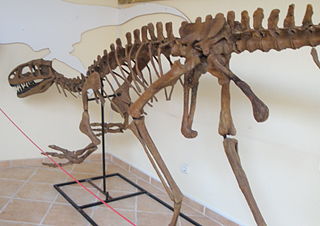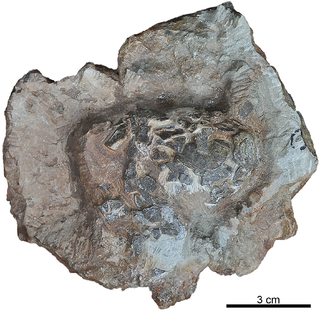
Torvosaurus is a genus of large megalosaurine theropod dinosaur that lived approximately 165 to 148 million years ago during the Callovian to Tithonian ages of the late Middle and Late Jurassic period in what is now Colorado, Portugal, Germany, and possibly England, Spain, Tanzania, and Uruguay. It contains two currently recognized species, Torvosaurus tanneri and Torvosaurus gurneyi, plus a third unnamed species from Germany.

Goniopholis is an extinct genus of goniopholidid crocodyliform that lived in Europe and North America during the Late Jurassic and Early Cretaceous. Like other goniopholidids, it resembled living crocodilians, and probably had a similar ecology as semi-aquatic ambush predators.
Dracopelta is a monospecific genus of ankylosaur dinosaur from Portugal that lived during the Late Jurassic in what is now the Lourinhã Formation. The type and only species is Dracopelta zbyszewskii, which is represented by a partial skeleton including unpublished material.

Draconyx is a genus of dinosaur from the Late Jurassic. It was an ornithopod which lived in what is now Portugal and was a herbivore. It was found in the Lourinhã Formation in 1991, and described by Octávio Mateus and Miguel Telles Antunes in 2001.

Lusotitan is a genus of herbivorous brachiosaurid sauropod dinosaur from the Late Jurassic Period of Portugal.

Lourinhanosaurus was a genus of carnivorous theropod dinosaur that lived during the Late Jurassic Period (Kimmeridgian/Tithonian) in Portugal. It is one of many large predators discovered at the Lourinhã Formation and probably competed with coeval Torvosaurus gurneyi, Allosaurus europaeus, and Ceratosaurus.

Crocodylomorpha is a group of pseudosuchian archosaurs that includes the crocodilians and their extinct relatives. They were the only members of Pseudosuchia to survive the end-Triassic extinction. Extinct crocodylomorphs were considerably more ecologically diverse than modern crocodillians. The earliest and most primitive crocodylomorphs are represented by "sphenosuchians", a paraphyletic assemblage containing small-bodied, slender forms with elongated limbs that walked upright, which represents the ancestral morphology of Crocodylomorpha. These forms persisted until the end of the Jurassic. During the Jurassic, crocodylomorphs morphologically diversified into numerous niches, with the subgroups Neosuchia and the extinct Thalattosuchia adapting to aquatic life, while some terrestrial groups adopted herbivorous and omnivorous lifestyles. Terrestrial crocodylomorphs would continue to co-exist alongside aquatic forms until becoming extinct during the Miocene.

Octávio Mateus is a Portuguese dinosaur paleontologist and biologist Professor of Paleontology at the Faculdade de Ciências e Tecnologia da Universidade Nova de Lisboa. He graduated in Universidade de Évora and received his PhD at Universidade Nova de Lisboa in 2005. He collaborates with Museu da Lourinhã, known for their dinosaur collection.

Museu da Lourinhã, also known as the Lourinhã Museum, is a museum in the town of Lourinhã, west Portugal. It was founded in 1984 by GEAL - Grupo de Etnologia e Arqueologia da Lourinhã. The president of the Direction Board is Lubélia Gonçalves.

The Lourinhã Formation is a fossil rich geological formation in western Portugal, named for the municipality of Lourinhã. The formation is mostly Late Jurassic in age (Kimmeridgian/Tithonian), with the top of the formation extending into the earliest Cretaceous (Berriasian). It is notable for containing a fauna especially similar to that of the Morrison Formation in the United States and a lesser extent to the Tendaguru Formation in Tanzania. There are also similarities to the nearby Villar del Arzobispo Formation and Alcobaça Formation. The stratigraphy of the formation and the basin in general is complex and controversial, with the constituent member beds belonging to the formation varying between different authors.

Dinosaur eggs are the organic vessels in which a dinosaur embryo develops. When the first scientifically documented remains of non-avian dinosaurs were being described in England during the 1820s, it was presumed that dinosaurs had laid eggs because they were reptiles. In 1859, the first scientifically documented dinosaur egg fossils were discovered in France by Jean-Jacques Poech, although they were mistaken for giant bird eggs.
Preprismatoolithus is a Late Jurassic oogenus. The species P. coloradensis is described by John Foster as being "of the prismatic basic type," with subspherical eggs about 10 cm (4 inches) in diameter. This oospecies has been initially attributed to "hypsilophodontid" dinosaurs, although a lack of associated embryo material currently makes confirming the egg-layer's identity impossible, but now is known to be theropod after the finding in Portugal, associated with the embryos.

Dendroolithus is an oogenus of Dendroolithid dinosaur egg found in the late Cenomanian Chichengshan Formation, in the Gong-An-Zhai and Santonian Majiacun Formations of China and the Maastrichtian Nemegt and Campanian Barun Goyot Formation of Mongolia. They can be up to 162 mm long and 130 mm wide. These eggs may have been laid by a Therizinosaur, Sauropod, or Ornithopod. The oospecies "D." shangtangensis was originally classified as Dendroolithus, however, it has since been moved to its own distinct oogenus, Similifaveoloolithus. This oogenus is related with embryos of the theropod Torvosaurus

Prismatoolithus is an oogenus of dinosaur egg from the Cretaceous (Hauterivian-Maastrichtian) and possibly also the earliest Paleocene. They likely belonged to troodontids
Bauruoolithus is an oogenus of fossilized eggs belonging to an extinct crocodyliform from the Late Cretaceous of Brazil. Bauruoolithus eggs were most likely laid by the notosuchian crocodyliform Baurusuchus. Eggs of Bauruoolithus were described in 2011 from the Adamantina Formation. The type oospecies is B. fragilis.

Krokolithes is an oogenus of Crocodiloid eggs. These eggs were laid by an extinct species of Crocodylian. It contains three oospecies: K. dinophilus, K. wilsoni and K. helleri. 1 Fossils of the oogenus have been found in the Oligocene of France, the Oldman and Dinosaur Park Formations of Alberta, Canada, the Campanian Two Medicine Formation of Montana, the Barremian Cabezo Gordo Member of the Blesa Formation of Spain, and the Kimmeridgian of the Lourinhã Formation of Portugal.
Krokolithidae is an oofamily of fossil crocodylomorph eggs. The oogenus Mycomorphoolithus is closely related to the family, but not included in it.
Coralloidoolithus is an oogenus of dinosaur egg from the Tiantai Basin in Zhejiang Province, containing a single known oospecies C. shizuiwanensis. Formerly, it was classified in the oogenus Paraspheroolithus; however, it was considered sufficiently different to be classified in its own genus. C. shizuiwanensis is similar to Stalicoolithus, leading to their classification in the same family, Stalicoolithidae.
Mycomorphoolithus is an oogenus of fossil eggs found in Spain and England. They possibly represent eggshells of non-eusuchian crocodylomorphs, and are similar to, but not part of, the Krokolithidae.

Plesiopharos is an extinct genus of plesiosaur from the Early Jurassic Coimbra Formation of Portugal. Specifically, it was discovered in São Pedro de Moel, Marinha Grande, from which the type species' binomial name, Plesiopharos moelensis, derives from.















